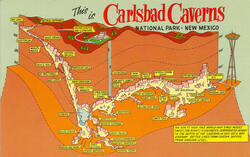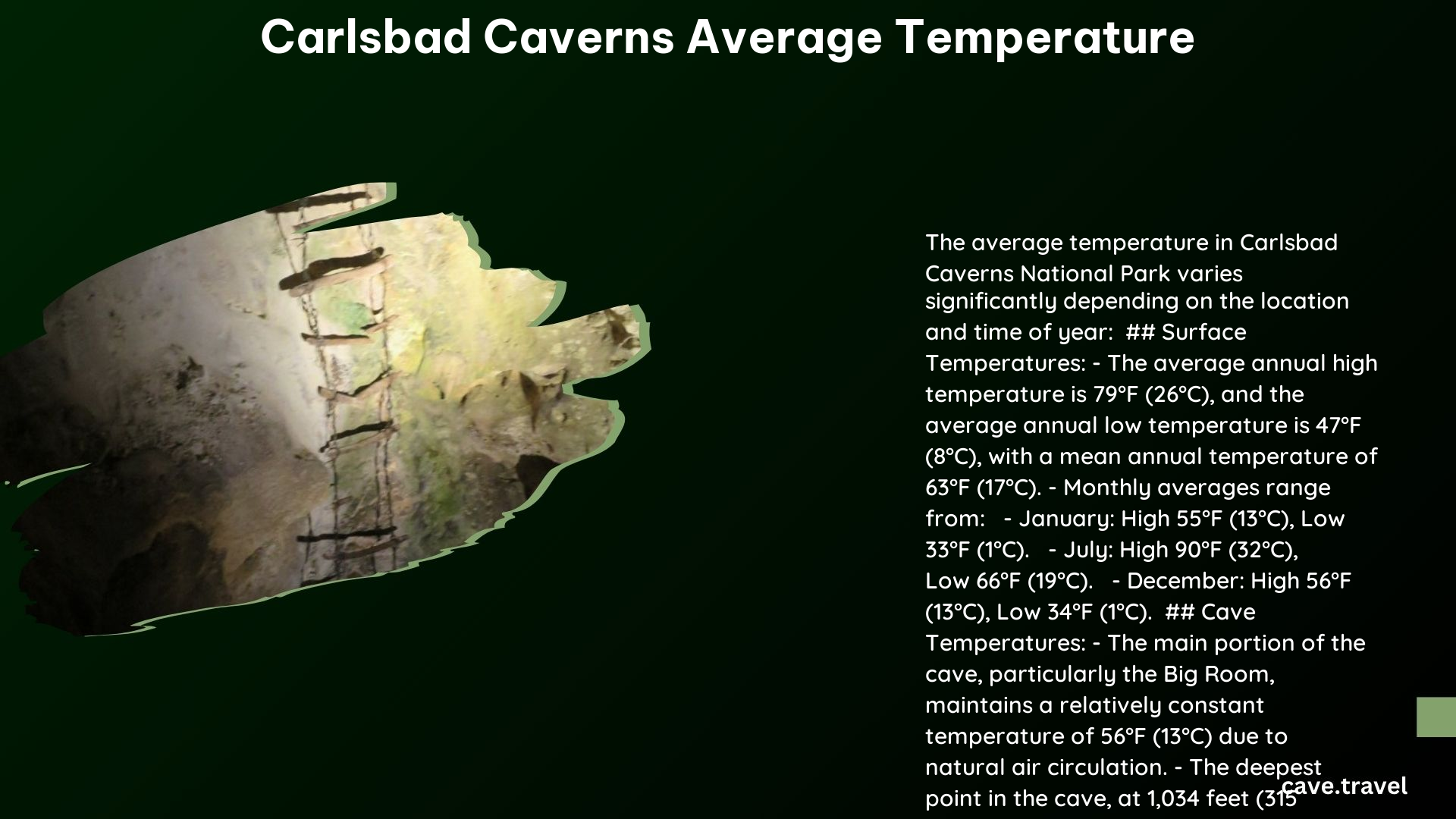Carlsbad Caverns, a renowned underground wonder, maintains a unique temperature profile distinct from its surface environment. The caverns’ average temperature hovers around 56°F (13°C) in the main areas, while deeper sections reach 68°F (20°C). This stable climate, coupled with high humidity, creates a microenvironment that differs significantly from the variable surface temperatures. Understanding these temperature dynamics is crucial for visitors and researchers alike, as it impacts both the cave ecosystem and the visitor experience.
What is the Surface Temperature at Carlsbad Caverns?

The surface temperature at Carlsbad Caverns National Park experiences significant fluctuations throughout the year:
- Average annual high: 79°F (26°C)
- Average annual low: 47°F (8°C)
- Mean annual temperature: 63°F (17°C)
These variations create a stark contrast to the more stable environment found within the caverns themselves.
How Does the Cave Temperature Compare to the Surface?

The temperature inside Carlsbad Caverns remains relatively constant compared to the surface:
- Main cave areas (including the Big Room):
- Average temperature: 56°F (13°C)
-
12°F (-11°C) cooler than other parts of the cave system
-
Deepest point (1,034 feet / 315 meters below surface):
- Temperature: 68°F (20°C)
- Relative humidity: Close to 100%
This temperature difference is due to the cave’s unique geological features and air circulation patterns.
What Factors Contribute to the Stable Cave Climate?
Several factors contribute to the stable climate within Carlsbad Caverns:
- Depth: The deeper sections of the cave are less affected by surface temperature fluctuations.
- Rock insulation: The surrounding rock acts as a natural insulator, maintaining consistent temperatures.
- Limited air exchange: Restricted airflow between the surface and cave interior helps maintain stable conditions.
- Geothermal heat: Larger cave systems can capture some heat rising from Earth’s core, slightly elevating temperatures in deeper areas.
How Do Seasonal Changes Affect Cave Temperatures?
While the cave’s temperature remains relatively stable, some seasonal fluctuations do occur:
- Winter:
- Cold, dry air enters the cave
- Humidity in the Big Room can drop to 87.5%
-
Slight temperature decrease in areas near the entrance
-
Summer:
- Warmer, moist air is displaced
- Humidity in most areas approaches 100%
- Minimal temperature changes in deeper sections
These seasonal changes are most noticeable in areas closer to the cave entrance, such as the Big Room.
What is the Temperature Range Within Different Cave Sections?
The temperature range within Carlsbad Caverns varies depending on the location:
| Cave Section | Average Temperature | Humidity Range |
|---|---|---|
| Big Room | 56°F (13°C) | 87.5% – 100% |
| Deepest Point | 68°F (20°C) | Close to 100% |
| Entrance Area | Variable | Variable |
This temperature gradient creates distinct microclimates within the cave system, supporting diverse ecosystems.
How Does Carlsbad Caverns Compare to Other Caves in the Area?
Carlsbad Caverns’ temperature profile is unique compared to other caves in the region:
- Lechuguilla Cave (within Carlsbad Caverns National Park):
- Average temperature: 68°F (20°C)
- Constant relative humidity: Close to 100%
- Minimal influence from surface conditions due to small entrance
The temperature difference between Carlsbad Caverns and Lechuguilla Cave highlights the impact of cave geometry and air circulation on internal climates.
What Should Visitors Expect Regarding Cave Temperatures?
Visitors to Carlsbad Caverns should be prepared for consistent cool temperatures:
- Dress in layers: The 56°F (13°C) average temperature can feel chilly, especially during extended tours.
- Bring a light jacket: Even in summer, the cave remains cool.
- Wear comfortable, closed-toe shoes: The cave floor can be damp and slippery in places.
- Expect temperature changes: Moving between different cave sections may result in slight temperature variations.
- Be aware of humidity: The high humidity can make the cave feel cooler than the actual temperature.
How Do Cave Temperatures Affect the Ecosystem?
The stable temperatures within Carlsbad Caverns play a crucial role in supporting the cave’s unique ecosystem:
- Bat populations: The consistent climate provides ideal conditions for bat roosting and hibernation.
- Cave-adapted species: Many organisms have evolved to thrive in the cool, humid environment.
- Microbial communities: Specialized microorganisms flourish in the stable conditions, contributing to cave formation processes.
- Mineral formations: The constant temperature and humidity facilitate the slow growth of delicate cave formations like stalactites and stalagmites.
Understanding these temperature dynamics is essential for preserving the delicate balance of Carlsbad Caverns’ ecosystem.
What Research is Being Conducted on Cave Temperatures?
Ongoing research at Carlsbad Caverns focuses on various aspects of cave temperature:
- Climate change impacts: Scientists are monitoring how surface temperature changes may affect cave climates over time.
- Microclimate mapping: Detailed studies of temperature and humidity variations throughout the cave system.
- Air circulation patterns: Research on how air movement influences temperature distribution within the caverns.
- Ecosystem adaptations: Investigations into how cave-dwelling organisms respond to subtle temperature fluctuations.
- Speleothem growth rates: Studies on how temperature and humidity affect the formation of cave decorations.
This research helps inform conservation efforts and improves our understanding of complex cave systems.
Carlsbad Caverns’ average temperature creates a unique subterranean environment that fascinates visitors and researchers alike. The stable climate, ranging from 56°F (13°C) in the main chambers to 68°F (20°C) in the deepest sections, supports a diverse ecosystem and preserves delicate geological formations. As climate change potentially impacts surface conditions, ongoing monitoring and research of cave temperatures become increasingly important for the long-term preservation of this natural wonder.
References:
1. Weather – Carlsbad Caverns National Park (National Park Service)
2. Climate in Carlsbad Caverns National Park (Weather Spark)
3. Carlsbad Caverns Weather Stats & Forecast (National Parked)
